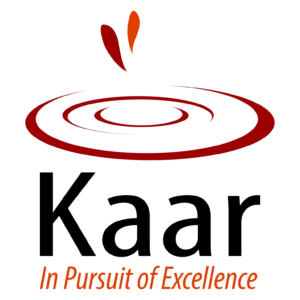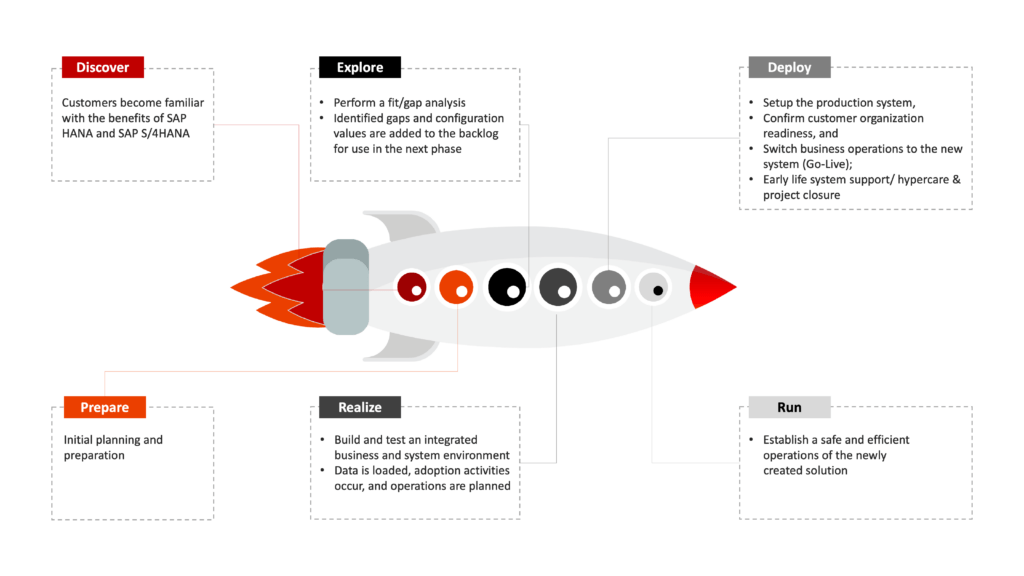Are you currently transforming or in the process of opting transformation to SAP S/4HANA?
Congratulations! This is a significant step and an interesting adventure.
Since you already know about SAP S/4HANA you must also be hearing about SAP Activate.
If not, you soon will!
Every SAP S/4HANA implementation follows the SAP Activate approach. SAP Activate Methodology is a comprehensive approach for managing SAP projects from start to implementation.
In this post, we will list down the 6 phases of the activate methodology and we will focus mainly on the Explore phase, providing a comprehensive guide to its processes and key deliverables.
By the end of this post, you will have a clear understanding of what is involved in this phase and how to ensure a successful start to your SAP project.
If you still haven’t read our earlier introductory blog for the SAP Activate Framework, Do check it out by clicking on this link.
In addition to the SAP Activate Methodology, there are two other main components that make up the total SAP Activate framework. If you are really excited to know what’s it just click here.
SAP Activate Methodology is divided into 6 phases. In this blog, we will be talking specifically about the Explore phase
6 Phases of SAP Activate Methodology
The phases involved in the SAP Activate Methodology are:
- Phase 1: Discover
- Phase 2: Prepare
- Phase 3: Explore
- Phase 4: Realize
- Phase 5: Deploy
- Phase 6: Run
Curious about SAP Activate Methodology phases and want an in-depth understanding? Check it out here!
Now, let’s examine about the Explore Phase and the processes involved in the Explore Phase!
What is the Explore Phase?
The Explore Phase of the SAP Active Methodology is designed to provide a comprehensive understanding of the project and its requirements. This phase is critical to the success of the project, as it establishes the foundation for the entire project and ensures that all stakeholders are aligned.
Processes involved in Explore Phase:
Here are some of the processes involved in this phase:
➔ Identify Project Scope: The first step is to identify the project scope along with its objectives, business goals, stakeholders, potential risks, and assumptions.
➔ Conduct Kick-off Meeting: A kick-off meeting is held with stakeholders to identify the project’s objectives and make sure that all stakeholders have the same understandings of the project scope. This helps in ensuring alignment and a consistent vision.
➔ Define Business Process Requirements: This phase involves an in-depth analysis of the current business processes of the customer by conducting workshops with various stakeholders. This step allows SAP experts to identify bottlenecks and streamline the process.
➔ Requirement Prioritization: Once the requirement gathering process is complete, the next step is to prioritize business requirements based on their criticality. Critically analyzing requirements ensures that scarce resources are used effectively.
➔ Define Solution Requirements: In this step, the technical and functional requirements for the customized SAP solution are identified.
➔ Proof of Concept: A proof of concept project is conducted to validate solution feasibility, assess viability, and meet customer needs. It involves a preliminary project to build confidence before full-scale deployment.
➔ Business Blueprint: The Business Blueprint document is created, which outlines the project’s required configurations and functional specifications.
➔ Sign off: The customer representatives sign off on the Business Blueprint document, which means they approve the proposed solution approach and can visualize the end-to-end solution better.
These are the primary processes involved in this phase. Let us walk through, and understand some of the key deliverables of Explore Phase.
Key Deliverables of Explore Phase
The key deliverables are as follows:
-
Execution and monitoring of the project:
To make sure that the project goals are being met within the allotted budget and timeline the following points must be considered,
➔ A thorough project plan must be created.
➔ Milestones must be identified
➔ Progress must be tracked.
The above points explains the importance of creating a project charter during the Explore phase as it outlines the project’s objectives, scope, stakeholders, and a high-level timeline. However, its significance goes beyond mere documentation as this charter serves as a solid foundation for seamless execution and effective monitoring throughout the project life cycle.
-
Fit-to-standard analysis:
“Fit-to-standard analysis” refers to the evaluation of a company’s existing business processes to assess their compatibility with SAP’s best practices. It involves assessing the extent to which SAP’s standard processes align with the company’s current operations.
The following are significant results from the Fit-to-Standard analysis in the Explore phase:
➔ Utilize the predefined configuration in the SAP S/4HANA Cloud solution to promote adoption, enabling your business to innovate with each SAP S/4HANA Cloud release.
➔ Engage subject matter experts in the discussions when you attend the Fit-to-Standard courses.
➔ Prioritize items according to high relevance for any solution improvements or additional configuration that is needed to maintain project timetables and expectations on track. Instead of a single, massive deployment, consider a number of smaller, incremental releases to the business.
-
Company execution of standard:
Certainly! When it comes to the “Company execution of standard” deliverable during the explore phase, the focus is on ensuring how the company adopts and follows SAP’s standard procedures to achieve optimal effectiveness and efficiency.
Here are some additional points to consider for this deliverable:
➔ Standard Process Familiarization: Familiarize project team and stakeholders with SAP’s standard processes and procedures by studying documentation, reference materials, and best practice guidelines
➔ Process Fit Assessment: Assess existing processes and identify areas where they can be directly adopted or require minimal customization, determining the level of effort needed for process alignment.
➔ Stakeholder Engagement: Engage key stakeholders in the execution of SAP’s standard processes to secure their commitment and support.
➔ Governance and Enforcement: Implement governance mechanisms to enforce SAP’s standard procedures, such as process owners, accountability, and audits, to maintain consistency and accountability.
-
Analytics planning and design:
The Organizations engage in data gathering and analysis to comprehend their current state, identify areas for improvement, and devise strategies accordingly. This involves utilizing analytical techniques such as descriptive, diagnostic, and predictive analytics to unveil patterns, trends, and correlations.
Furthermore, the insights gained from this process informs the development of strategic plans and initiatives through planning and design.
Overall, this phase plays a pivotal role in comprehending an organization’s current state, extracting insights from data, and using those insights to drive strategic planning. It serves as a foundation for effective decision-making and enables organizations to create a roadmap towards achieving their objectives.
-
Identity and access management planning:
During this phase, organizations are focused on understanding their current state of IAM, identifying potential risks and vulnerabilities, and formulating strategies to enhance their security posture.
Here are some key considerations and activities related to IAM during the Explore phase:
➔ Current IAM Assessment: Evaluates existing IAM infrastructure, policies, and processes to identify gaps.
➔ Risk Assessment: Conducts a comprehensive risk assessment to identify potential security risks.
➔ Data Classification and Governance: Defines data access controls and data handling guidelines to ensure proper protection and governance
-
Phase closure and sign-off:
Phase closure and sign-off marks the completion of the Explore phase in the overall project or initiative. It involves finalizing the activities, documentation deliverables and obtaining approval from key stakeholders before transitioning to the next phase.
The next phase after the Explore phase is typically the Realize phase. In Realize phase process requirements discovered during the fit-to-standard analysis workshops will be used as a sequence of agile iterations to incrementally create, test, and verify integrated business scenario.
Stay tuned for the next blog where we will cover the Realize phase of SAP Activate for SAP S/4HANA.
Final thought:
We hope that this comprehensive guide to the Explore phase of SAP’s Activate Methodology has provided you with a deeper understanding of its components and key deliverables. As one of the most important phases in the methodology, the Explore phase lays the foundation for the rest of the project.
By following the steps outlined in this blog, you can ensure that your project is on track, and your team is aligned from the start.
Thank you for reading, and we wish you all the best in your SAP implementation journey!
To know more, do contact our expertise!
FAQ’s
What is SAP Activate Methodology?
The SAP Activate Methodology is the next generation agile approach that delivers ready-to-run business processes optimized for S/4HANA software implementations with a reference solution designed for continuous innovation.
What are the phases of SAP activate methodology?
The six phases are Discover, Prepare, Explore, Realize, Deploy and Run
What is Explore phase in active methodology ?
The Explore Phase of the SAP Active Methodology is designed to provide a comprehensive understanding of the project and its requirements. This phase is critical to the success of the project, as it establishes the foundation for the entire project and ensures that all stakeholders are aligned.
What are the key deliverables of the Explore Phase?
The key deliverables of the Explore Phase include the execution and monitoring of the project, Fit-to-standard analysis, company execution of standard processes, solution definition, extensions planning and design, analytics planning and design.

